17. Characterization of Binding Media in Romano-Egyptian Funerary Portraits
Introduction
The identification of in funerary portraits is inherently complicated due to various factors such as restoration history, microbial deterioration, and environmental conditions (which are not always known). protocols were developed to identify waxes, oils, fatty acids, and proteins in forty-seven Romano-Egyptian funerary portraits. Analytical protocols utilized three separate derivatization techniques. The first analysis identified free fatty acids, wax esters, and fatty acid soaps; the second, oils and ; and the third, proteins. The identification of plant required a separate paint sample. Figure 17.1 shows the museums that participated in this study, the number of portraits tested, and the types of binding media identified. What follows is a brief summary of the binding media survey; further information—including GC/MS analytical data, protocol details, painting technique, and sample locations—is the subject of another article.1
Museum | Beeswax | Beeswax and Oil | Animal Glue | ||
|---|---|---|---|---|---|
J. Paul Getty Museum | 81.AP.42 73.AP.94 | 73.AP.91 79.AP.1414 78.AP.262 | 71.AP.72 74.AP.11 | 79.AP.2191 81.AP.29 79.AP.129 91.AP.63 79.AP.1426 | 74.AP.203 74.AP.213 74.AP.223 75.AP.871, 3 |
Santa Barbara Museum of Art | VL.2015.5 | ||||
Ny Carlsberg Glyptotek | AEIN 680 | AEIN 6813 AEIN 682 AEIN 683 AEIN 6843 | AEIN 14251 AEIN 14262 AEIN 14732 | ||
National Museum Denmark | AS 3891 | AS 3892 | AS 8940 | ||
Museum of Fine Arts, Houston, and the Menil Collection | 2009-16 TR:184-2013 | CA 7124 | CA 7013 | ||
Los Angeles County Museum of Art | M.71.73.62 | ||||
Walters Art Museum | 32.6 | 32.4 | |||
Ashmolean Museum | AN 1888.3425 | ||||
Phoebe A. Hearst Museum | 6-21377 | 5-2327 | |||
Petrie Museum | UC 196072 UC 300812 UC 339712 | UC 19608 UC 19610 | UC 19612 | UC 14768 | |
Cantor Arts Center | JLS.22252 | JLS.222262 | |||
Total Portraits (47) | 11 | 21 | 15 | ||
- 1
- shroud; all other portraits are on wooden panels
- 2
- paraffin wax
- 3
- egg coating
- 4
- Acacia sp. plant gum in ground
- 5
- animal glue in ground
- 6
- animal glue and Acacia sp. plant gum
Museum | Beeswax | Beeswax and Oil | Animal Glue | ||
|---|---|---|---|---|---|
J. Paul Getty Museum | 81.AP.42 73.AP.94 | 73.AP.91 79.AP.1414 78.AP.262 | 71.AP.72 74.AP.11 | 79.AP.2191 81.AP.29 79.AP.129 91.AP.63 79.AP.1426 | 74.AP.203 74.AP.213 74.AP.223 75.AP.871, 3 |
Santa Barbara Museum of Art | VL.2015.5 | ||||
Ny Carlsberg Glyptotek | AEIN 680 | AEIN 6813 AEIN 682 AEIN 683 AEIN 6843 | AEIN 14251 AEIN 14262 AEIN 14732 | ||
National Museum Denmark | AS 3891 | AS 3892 | AS 8940 | ||
Museum of Fine Arts, Houston, and the Menil Collection | 2009-16 TR:184-2013 | CA 7124 | CA 7013 | ||
Los Angeles County Museum of Art | M.71.73.62 | ||||
Walters Art Museum | 32.6 | 32.4 | |||
Ashmolean Museum | AN 1888.3425 | ||||
Phoebe A. Hearst Museum | 6-21377 | 5-2327 | |||
Petrie Museum | UC 196072 UC 300812 UC 339712 | UC 19608 UC 19610 | UC 19612 | UC 14768 | |
Cantor Arts Center | JLS.22252 | JLS.222262 | |||
Total Portraits (47) | 11 | 21 | 15 | ||
- 1
- shroud; all other portraits are on wooden panels
- 2
- paraffin wax
- 3
- egg coating
- 4
- Acacia sp. plant gum in ground
- 5
- animal glue in ground
- 6
- animal glue and Acacia sp. plant gum
Tempera
portraits were tested by GC/MS amino acid analysis, as this method allowed for the identification of proteinaceous binding media. The portraits’ samples were compared with common media, such as egg, , and casein. Results show that animal glue was the preferred tempera paint, as attested by a glue tempera portrait from the Petrie Museum (UC 14768; fig. 17.2a). The amino acids detected matched colllagen, the protein that makes up animal glue (fig. 17.2b). An earlier publication identified egg tempera in paint from UC 14768; however, this result was inaccurate due to interpretation error. It was based on fatty acids that are used to identify lipids and drying oils.2
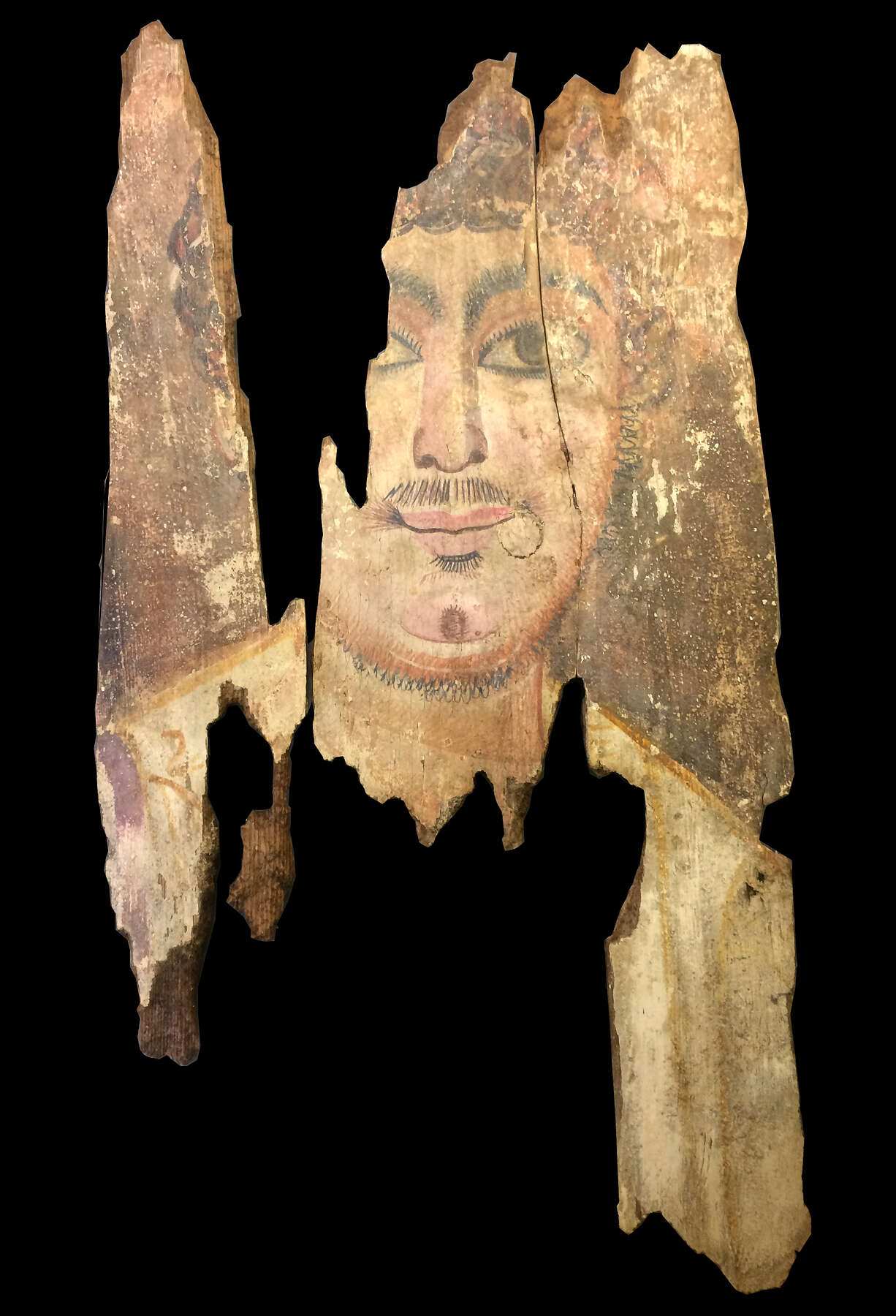 Figure 17.2a
Figure 17.2a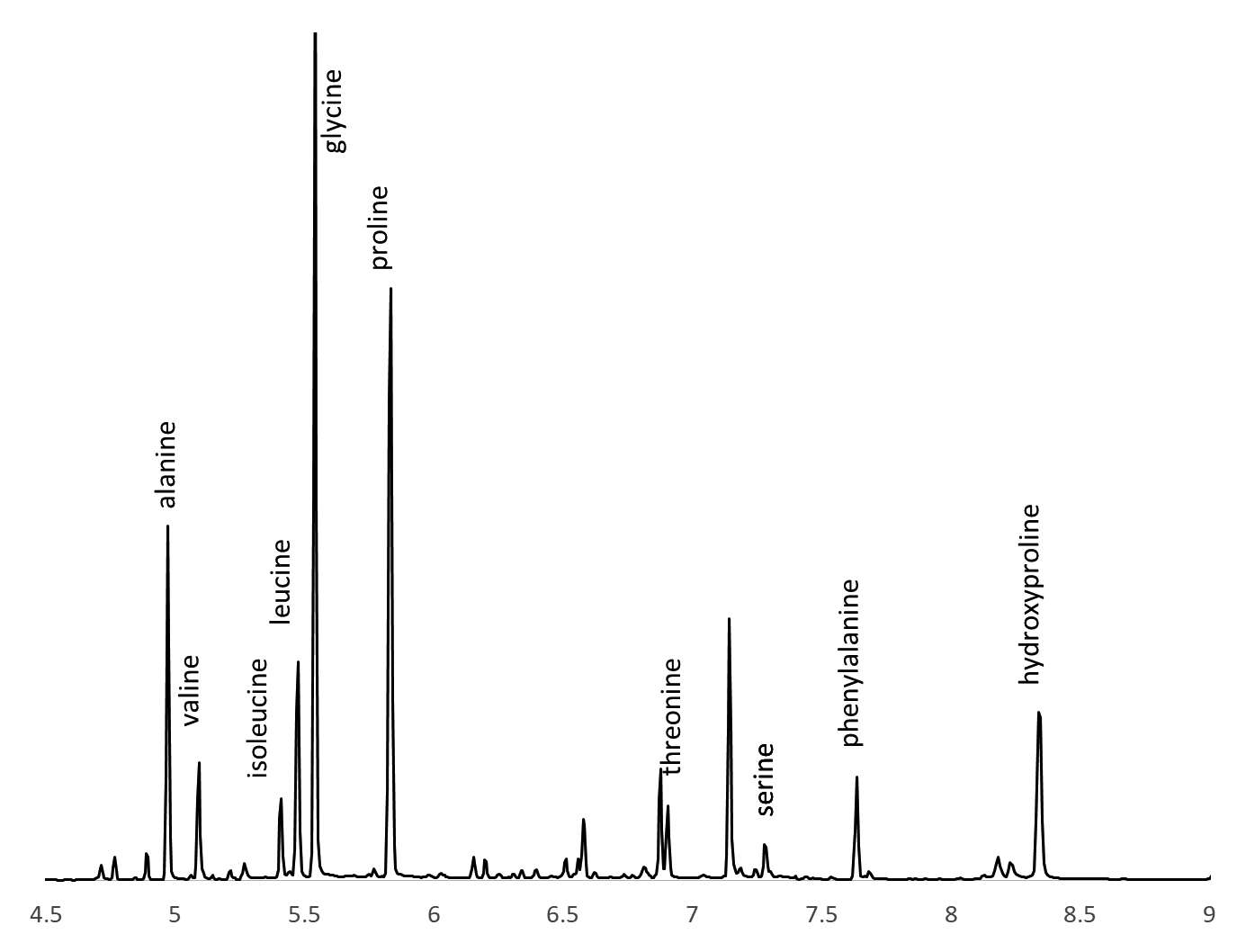 Figure 17.2b
Figure 17.2bdetected egg on the surface of four portraits from the Getty Museum (JPGM 74.AP.20–22, 91.AP.6). Egg coatings were also detected by GC/MS amino acid analysis on the surface of two portraits from the Ny Carlsberg Glyptotek.3 Future proteomic studies may help to determine the type of bird used to manufacture the egg coatings. Recently, cow skin (Bos taurus) was identified in JPGM 74.AP.20 with mass spectrometry, or peptide mass profiling, by comparing a sample from the portrait with different species of collagen.4
Plant gum was identified in the black from a mummy portrait (JPGM 79.AP.141), based on carbohydrate analysis. Animal glue was identified in the black ground of a similar portrait from the Ashmolean (AN 1888.342). Acacia sp. gum was identified in a gray paint sample from a glue-and-gum-tempera mummy portrait (JPGM 79.AP.142).
Encaustic
Thirty-two encaustic portraits were identified as beeswax portraits; they were analyzed for fatty acids, hydrocarbons, and wax esters by GC/MS. The investigation showed similar beeswax profiles for the majority of portraits, with considerable amounts of palmitic acid (C16)—likely present as palmitic acid —reduced alkanes (hydrocarbons), and decreased wax esters as compared with fresh beeswax. Results show that paint from the dark background of a beeswax mummy portrait (UC 19610; fig. 17.3a) had altered chemically, when compared with fresh beeswax (fig. 17.3b). The wax esters and alkanes had decreased substantially, while palmitic acid (C16) had increased.
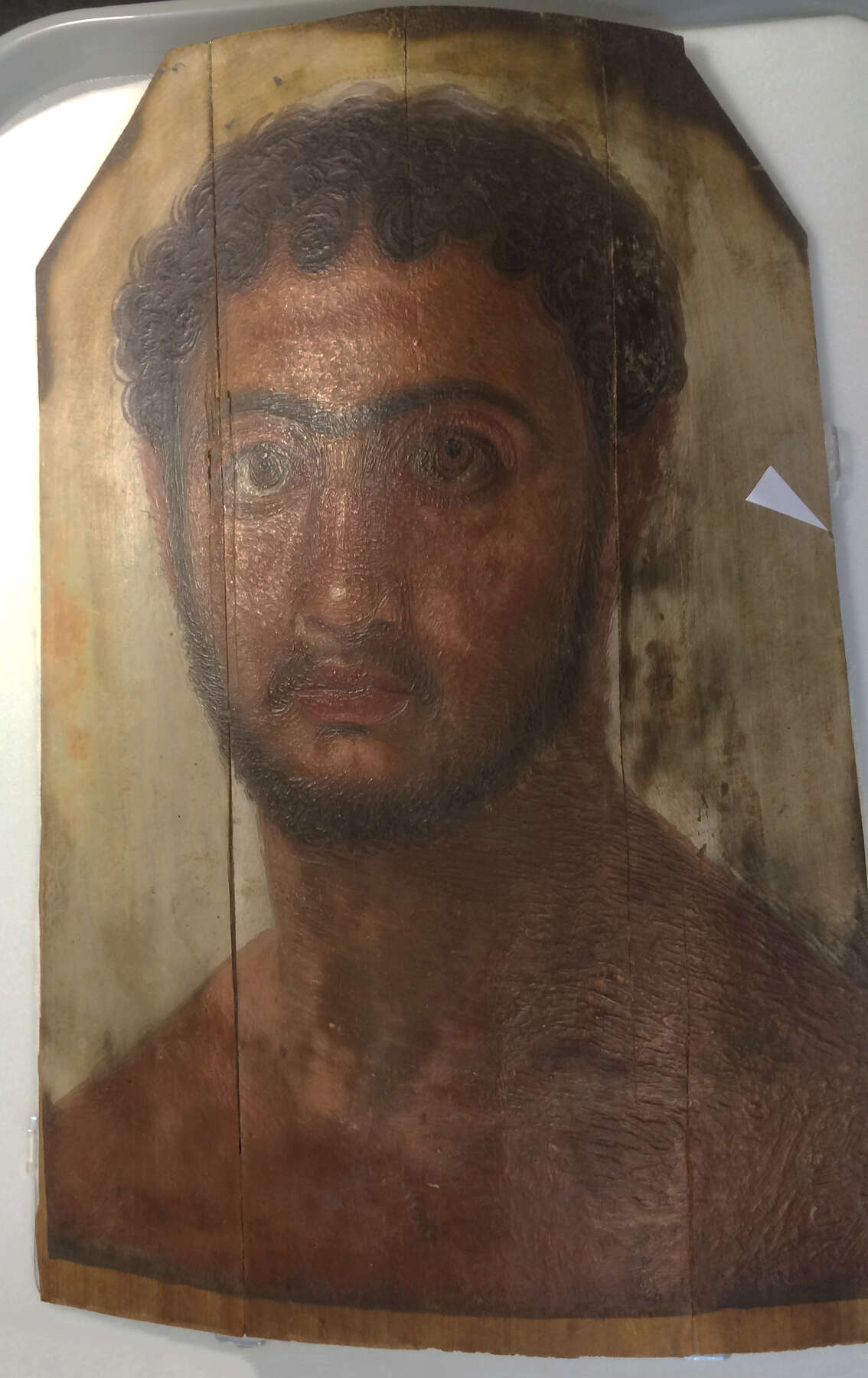 Figure 17.3a
Figure 17.3a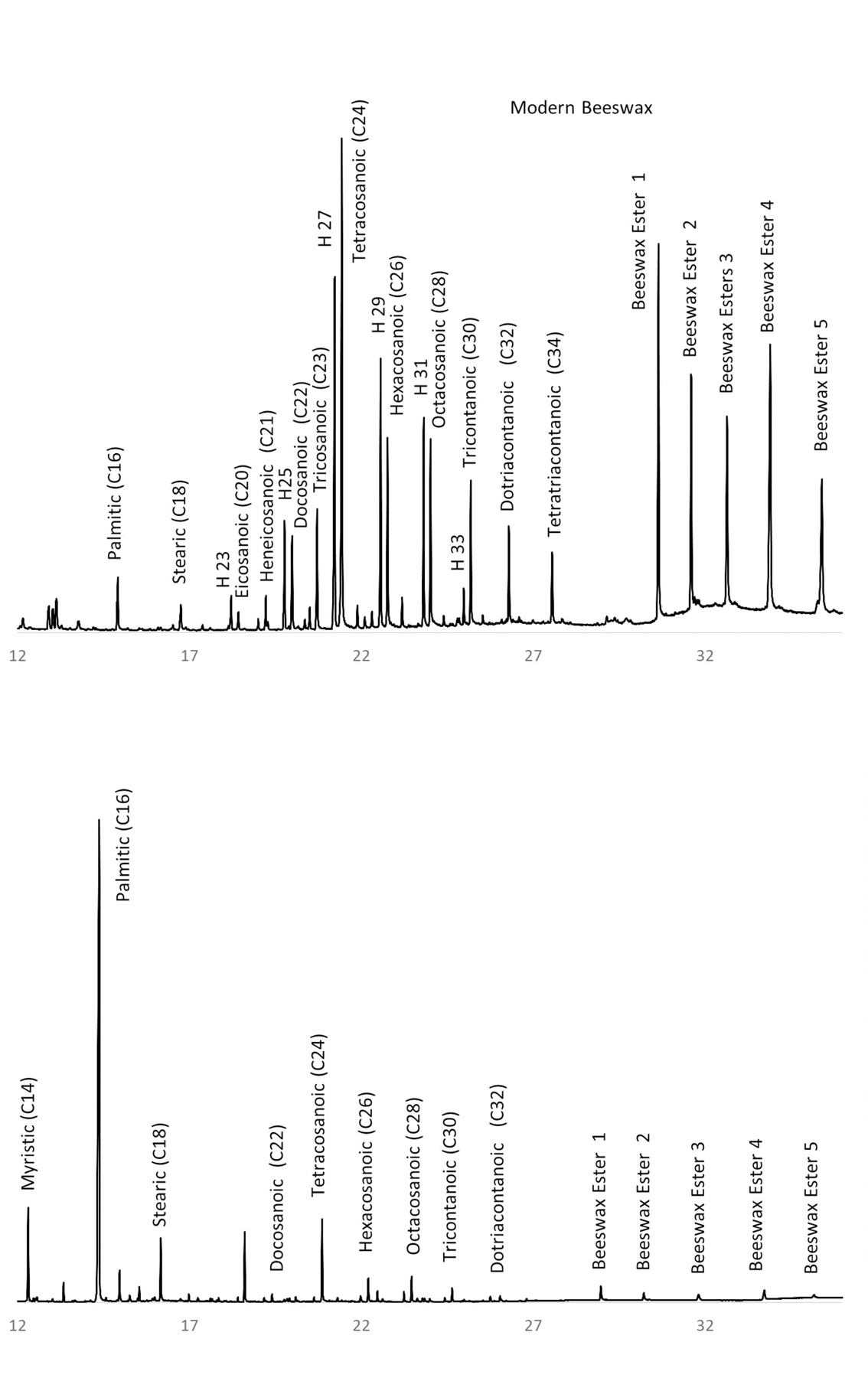 Figure 17.3b
Figure 17.3bBeeswax was likely applied melted, and little is known about the intentional modification by the artist in order to apply it while cold; this formulation is also called .5 Previous publications have described intentionally based on changes in chemistry—for example, low relative amounts of fatty acids, decreased alkanes and wax esters, and the presence of metal soaps.6 An early paper identified a modified wax, or “Punic wax,” in a beeswax mummy portrait (UC 19612), based on brushstrokes and decreased wax esters and alkanes.7
GC/MS analysis of UC 19612 shows that it was similar to most portraits tested; it had significant amounts of palmitic acid (as lead soap) and a decreased occurrence of wax esters and alkanes. The decreased content of wax esters (in comparison with fresh beeswax) does not necessarily mean it was intentionally modified, as similar wax profiles were observed in most portraits tested. Future research may shed light on the chemistry behind the decrease in wax esters and the subsequent reaction between palmitic acid and lead .
Oil Identification
GC/MS fatty acid analysis identified oil in twenty-one beeswax portraits (two on ) and one glue tempera portrait on linen (JPGM 75.AP.87; fig. 17.4a). Considered biomarkers for an oxidized oil, dicarboxylic fatty acids in paint are more likely to form in dry and arid climates. Figure 17.4b shows a chromatogram of JPGM 75.AP.87; it contains dicarboxylic fatty acids, indicating the presence of an oxidized oil. Brassicaceae (mustard, crucifers, and cabbage family) seed oil has been positively identified in Egyptian artifacts, based on similar dicarboxylic fatty acids.8 Further research and corroborative findings will help determine if these oils were intentionally added.
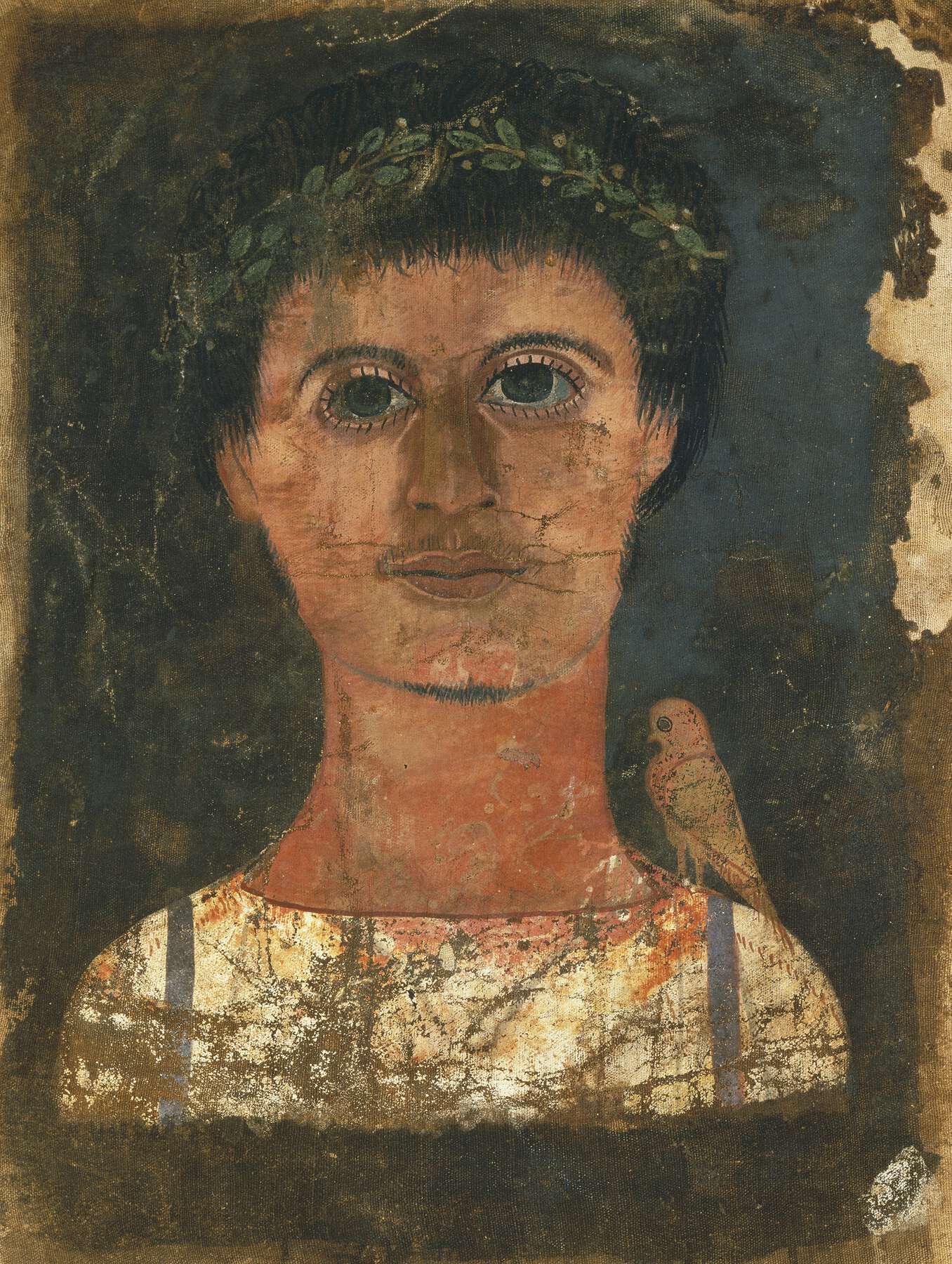 Figure 17.4a
Figure 17.4a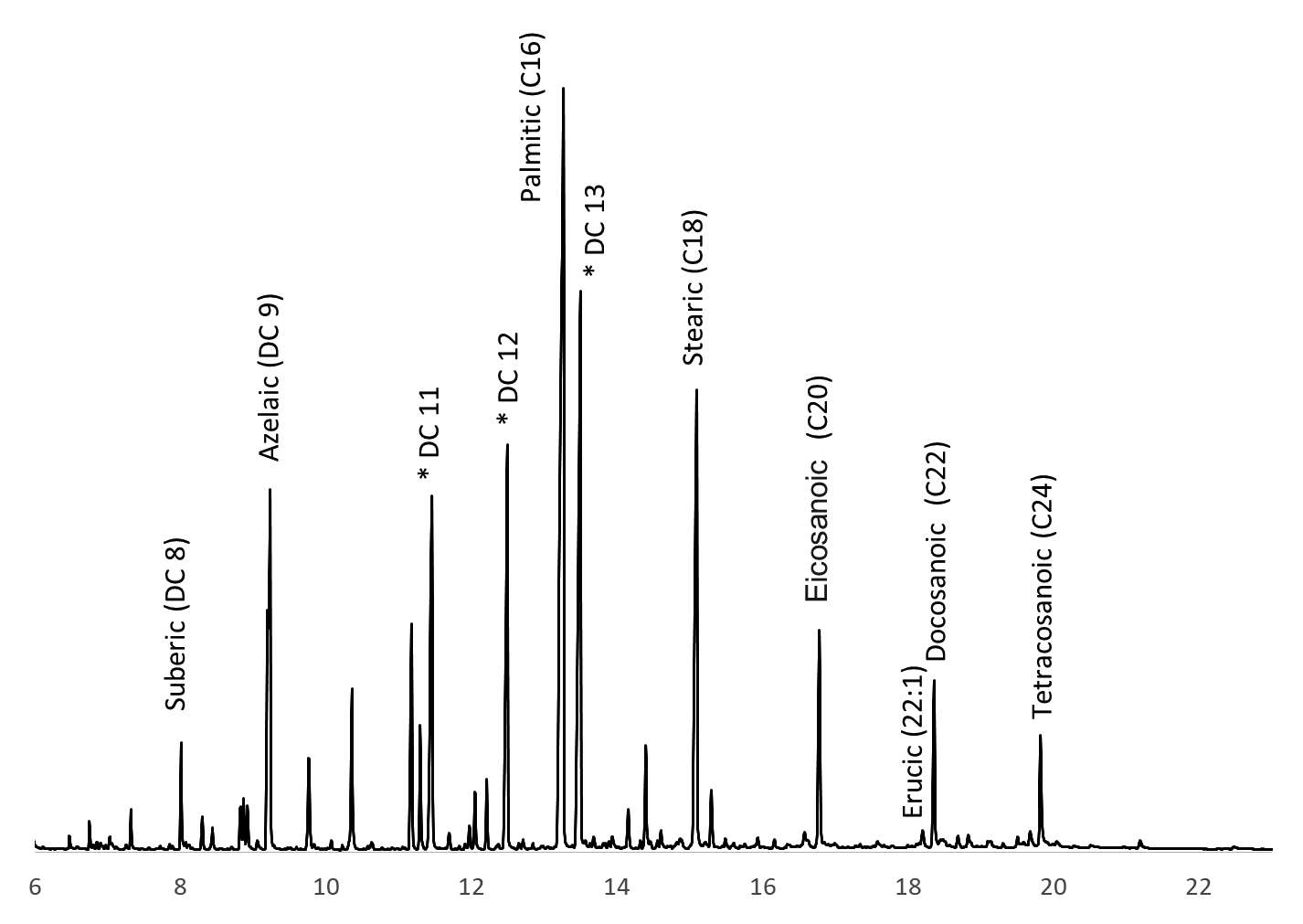 Figure 17.4b
Figure 17.4bConclusions
The GC/MS protocols were capable of identifying beeswax, fatty acids, soaps, oils, and proteins in one paint sample. Analysis of beeswax from mummy portraits showed a decrease in wax esters and hydrocarbons, while palmitic acid intensified—most likely present as fatty-acid lead soap. Animal glue was identified as the preferred medium in tempera portraits. Egg coatings were detected on two beeswax mummy portraits and three glue tempera panel portraits. Twenty-one beeswax portraits contained oxidation products of an unknown oil, based on the presence of dicarboxylic fatty acids. Future research may enable a better understanding of possible connections between the portraits’ and restoration history.
Notes
- . ↩
- . ↩
- ; see also Spaabæk and Mazurek, this volume. ↩
- . ↩
- See Sutherland, Sabino, and Pozzi, this volume. ↩
- , 1749; . ↩
- . ↩
- . ↩